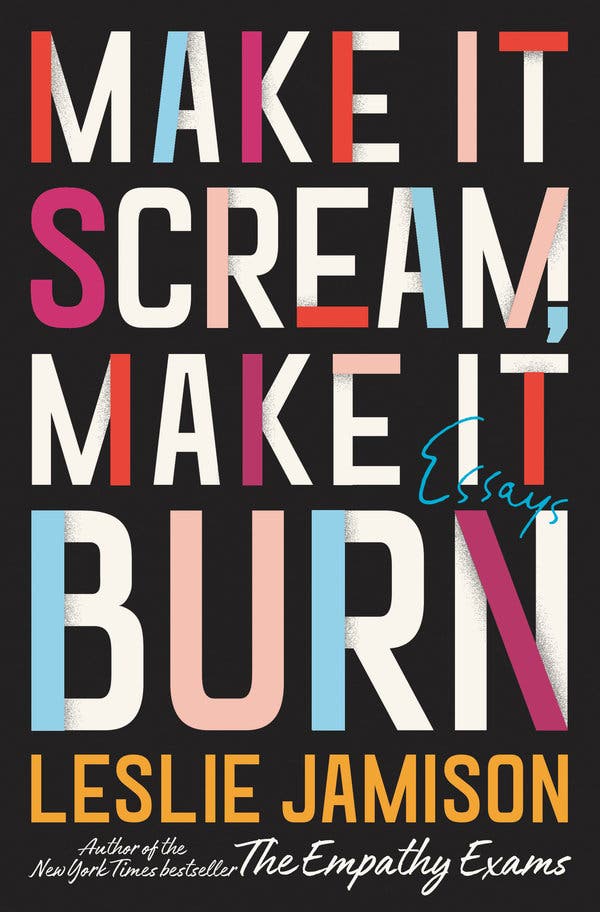MAKE IT SCREAM, MAKE IT BURN
Essays
By Leslie Jamison
Pity the personal essayist, fated to play with a reader’s tolerance for that most cursed of vowels. Too many “I”s and you’re self-absorbed; too few and: Where are you in this piece? Perhaps no other writer of her generation has wrestled with this conundrum more than Leslie Jamison. Her breakout collection, “The Empathy Exams,” deftly explored the balance between the inward and outward gaze and the intersection of the body’s frailty with the mind’s analytical prowess. (Her memoir, “The Recovering,” is also laden with spins and chills.)
Her second collection, “Make It Scream, Make It Burn,” is composed almost entirely of previously published pieces, an occupational hazard that can make the reader feel as if she’s wandered into a party to which she wasn’t invited. Taking a note from Joan Didion’s “Slouching Towards Bethlehem,” the book is divided into three sections: Longing (studies in “only connect”), Looking (criticism and travel) and Dwelling (personal excavation). Across all three, Jamison’s journalistic battle between sentiment and detachment rages on, sometimes resulting in texture, sometimes in tedium.
Without question, Jamison has impeccable taste in her own ideas, selecting fringe subjects and following them to the end of the road. “52 Blue” explores the cult of personality around a lonely whale onto which people project their own trauma. Jamison has a habit of evoking champion point-makers (Janet Malcolm, Susan Sontag, David Foster Wallace) to punctuate her own thoughts, but “52 Blue” contains one of the less obvious examples, that of the amateur astronomer Percival Lowell, who “claimed to have seen canals on Mars and shadowy ‘spokes’ on Venus. … An optometrist figured out that the settings on Lowell’s telescope — its magnification and narrow aperture — meant that it was essentially projecting the interior of his eye. He wasn’t seeing other life; he was seeing the imprint of his own gaze.” Elsewhere, “Sim Life” takes a deep dive into the game Second Life and its devotees, who have a “sense of not being fully included in the world.” “We Tell Ourselves Stories in Order to Live Again” (the title is a welcome flash of humor) opens with the story of a little boy convinced he is a “pilot shot down by the Japanese” during World War II. The essay goes on to uncover the world of “children who claimed to remember prior lives.”
If the first section is the most fully realized, the second is the most thematically rickety. There’s an analytic tome on James Agee (the title piece of the collection), two pieces on photography and “Up in Jaffina,” in which Jamison travels to Sri Lanka with 24 hours’ notice. As someone who completed the same assignment (but to Ecuador) for the same travel magazine, I found her observation that “this kind of spontaneity didn’t seem to permit anything but ignorance” spot on. Still, once she throws that out there, I wanted more than the repetitive discomfort that follows. “True statement: Sri Lanka is paradise. Also true: Every paradise is made possible by blindness.” Let no one accuse Jamison of living an unexamined life, but inertia can dull her points: “Maybe I wasn’t doing anyone any favors by pretending that my belief system was tolerant enough to hold everything as equally valid.” “Perhaps it was better to accept that not everything human was something I could know.” At one point, she questions her belief in her own tattoo.

She does none of this by accident. Jamison takes no steps that would threaten her intellectual authority. “In the academic programs where I’ve studied and taught, where bromides are kryptonite and emotion is expected to footnote its own presence, it is always risky to use the word love without cautionary quotes.” It’s just strange that someone who has focused so much of her writing on the body — hers, other people’s — can come off as a bit bloodless, neither screaming nor burning, her descriptions vying to out-flat one another.
The final section is the most personal. An essay on becoming a stepmother and another on the Museum of Broken Relationships (“relics from two-person civilizations that no longer existed”) are lovely and evocative planets unto themselves. The others less so. “Rehearsals,” on weddings, is written in the allegedly universal second person but feels like a tactic to distance Jamison from girlish terrain, and “The Long Trick” is an oddly monotonous tribute to the men in her family. “The Quickening,” the final, revealing essay about her own pregnancy, feels less harrowing and more there for the sake of bringing our host into the present tense.
Reviews of essay collections invariably note the “strongest” pieces, but “Make It Scream, Make It Burn” is a reminder that strength is not a catchall. If we decide strength is about structure and elucidation, then most of these essays are heavyweight boxers. If, however, strength is about persuasion, transformation or the evocation of emotion, it’s in short supply here. We are all Percival Lowell, our lives subject to the imprint of our own gaze. Stare too long at the gaze itself and it becomes hard to see what you’re looking at.

